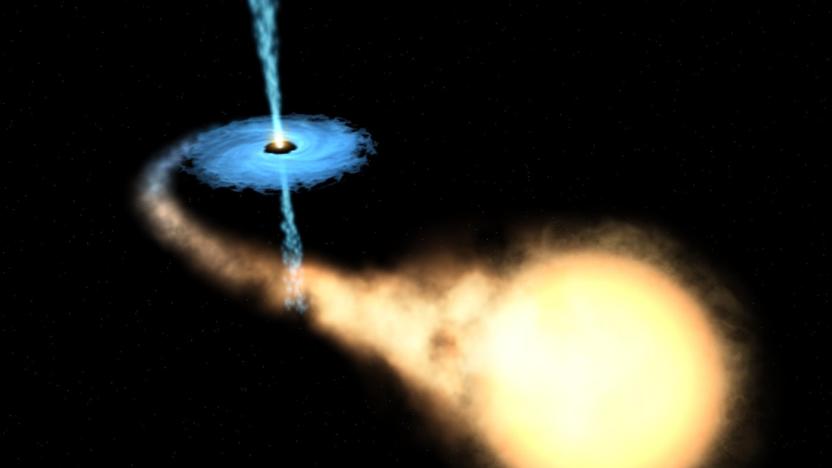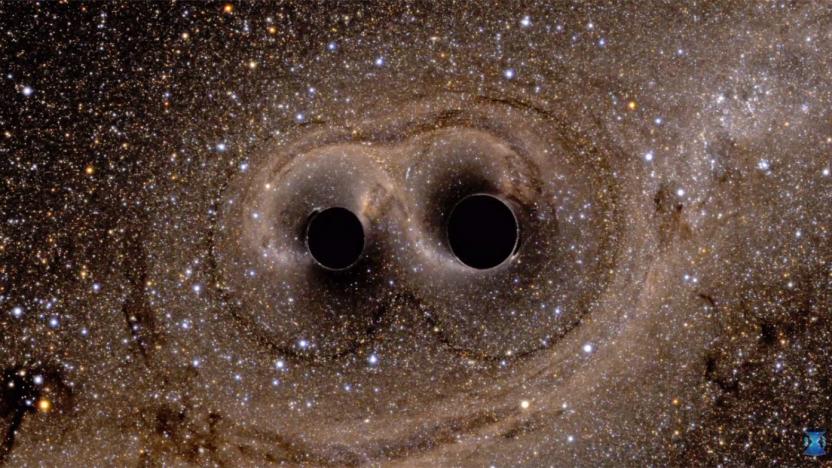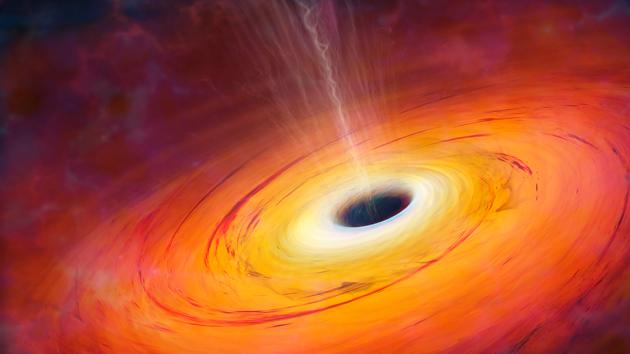BlackHole
Latest

A lab-made black hole supports longstanding Hawking theory
In 1974, Stephen Hawking put forward a hypothesis suggesting radiation can escape the light-sucking grip of a black hole. This week, and over forty years later, newly published research claims to have observed "Hawking radiation" (as it is known) in lab conditions. How do you observe the mother of cosmic monsters in a science lab? With a sonic black hole, a commonly used analogue (that doesn't swallow your research lab).

Astronomers discover a nearby 'hidden' black hole
Astronomers compared data (and notes, we'd like to imagine) on a "peculiar" source of radio waves, concluding that what was once thought to be a distant galaxy is actually a nearby binary star system, made up of a low-mass star and a black hole. It took data from NASA's Chandra X-ray Observatory, the Hubble Space Telescope and the National Science Foundation's Karl G. Jansky Very Large Array (VLA) to realize this -- and now researchers reckon there could be more hidden black holes out there.

ICYMI: Gravitational waves and holographic Holocaust memory
try{document.getElementById("aol-cms-player-1").style.display="none";}catch(e){}Today on In Case You Missed It: NASA's mission to figure out where black holes are located won't actually deploy until 2034, but the science behind the sound experiment is being worked on now. University of Southern California's Institute for Creative Technologies created a 3D video rig to capture people's memories, saving the video and sound mash-up for future generations to hear first-hand accounts of the Holocaust. The "In Good Company" shoe for turning off phone notifications automatically is here; in case you're interested in the human ancestor story, NPR has a good summary here. As always, please share any great tech or science videos you find by using the #ICYMI hashtag on Twitter for @mskerryd.

New algorithm may lead to a picture of an actual black hole
MIT grad student Katie Bouman and her team have developed an algorithm that could finally show us a photo of an actual black hole. See, all the black hole "photos" you've seen thus far, including the one above, are merely artist interpretations depicting what we think they look like. In order to capture, say, a picture of the supermassive black hole in the center of our own galaxy, we'll need an enormous telescope with a diameter almost as big as our planet. Since it's impossible to build something that massive, Bouman's algorithm called Continuous High-resolution Image Reconstruction using Patch priors or CHIRP stitches data gathered by the Event Horizon Telescope array.

Two black holes are defying the limits of science
Even astrophysicists are occasionally surprised at what they find in the cosmos. University of Cambridge researchers have discovered that two black holes are consuming their companion stars at rates much faster than currently established limits would allow -- so fast, in fact, that the gas is ejecting at a quarter of the speed of light. To top things off, this is the first time that scientists have seen winds flowing away from ultra-luminous (and currently mysterious) X-ray sources.

Astronomers find a supersized black hole in a cosmic small town
The humongous black hole in the center of a galaxy called NGC 1600 took the MASSIVE Survey astronomers by surprise. It's not only almost as big as the largest one we've discovered, it's also located in a sparsely populated region of only 20 or so galaxies, 200 million light years away. To note, it's 17 billion times bigger than our sun, while the largest one that we know of is 21 billion times larger. Supermassive black holes, which weigh at least 10 billion suns, are typically found in the center of huge galaxies that reside in heavily populated areas. NASA says finding NGC 1600's was like finding a skyscraper in the middle of a small town.

Science confirms that gravitational waves exist
At last, scientists have validated a key part of Einstein's general theory of relativity. The National Science Foundation, Caltech and MIT have confirmed the existence of gravitational waves, or ripples in spacetime. Their two LIGO (Laser Interferometer Gravitational-wave Observatory) detectors measured atomic-scale differences on September 14th, 2015 that point to the collision of black holes (also a new discovery) 1.3 billion years ago, triggering gravity ripples that only just reached Earth. There have long been hints of these waves, but hard evidence has proven elusive until now.

A supermassive black hole is shooting X-rays across galaxies
NASA doesn't often compare things to a Death Star, but a phenomenon observed by its Chandra X-ray Observatory apparently qualifies. The composite image above shows a supermassive black hole that is continuously stripping material from nearby stars and other objects with its enormous gravity. When the material hits the "event horizon," a massive gravitational blast produces a particle jet that spans nearly 300,000 light years, three times the width of the entire Milky Way galaxy. That amount of power is pretty alarming, but luckily it's around 500 million light years away from us in the Pictor A galaxy.

We could finally see an event horizon in 2017
Event horizons remain shrouded in mystery (and is depicted as the gateway to hell by a certain sci-fi horror flick) for good reason. Since they don't emit or reflect light, they're notoriously hard to photograph. The good news is that the Event Horizons Telescope's development is on track and could give us a peek into the heart of Milky Way's black hole called Sagittarius A* as soon as early 2017. Team member Feryal Ozel told BBC News during an astronomy event in Florida that the project is "almost there."

Black hole ejects massive energy jet after devouring a star
For the first time, scientists have caught a glimpse of a black hole ejecting a hot "flare" of matter after devouring a star the size of our sun. The discovery was made thanks to the quick action of of scientists from John Hopkins University, who worked in conjunction with a team from the University of Oxford. Hubble fellow Sjoert van Velzen from Hopkins heard last year that Ohio State U researchers had spotted a transient star that was caught in the gravitational pull of a black hole some 300 million light years away. In theory, the event (dubbed ASASSN-14li) would result in a "tidal disruption" of the star, resulting in a hot flare burst energy jet emitted by the supermassive black hole.

Astronomers spot a mid-sized black hole
Black holes typically come in one of two sizes: stellar mass and supermassive. Astronomers believe that there are black holes that fit between these two extremes but finding them has proven difficult, with only a half-dozen candidates currently known. Well, as of today, the tally rises to half-dozen plus one. Scientists at the University of Maryland and NASA's Goddard Space Flight Centre have found another mid-sized black hole, weighing in at 5,000 times the mass of our Sun.

The black hole imagery of 'Interstellar' is helping astrophysics
You may have heard that the representation of a black hole in Interstellar was not only based on real science, but might tackle researchers' problems depicting these gravitational points. Well, that just happened -- physicist Kip Thorne and visual effects outfit Double Negative have published papers detailing the code used to portray the movie's black hole, Gargantua. Rather than trace individual light rays, they followed the paths and shapes of the millions of distorted beams traveling around the hole. The technique eliminates flickering effects that not only wreck your moviegoing experience, but prevent astrophysicists from getting a clear picture of what such a scene would look like in real life.

The Big Picture: measuring the 'Eye of Sauron' galaxy
The galaxy you see here (NGC 4151) may be best-known for looking a bit like the Eye of Sauron in the Lord of the Rings movies, but it's now much more important than that -- it may be the key to mapping the universe. Researchers at the Univerity of Southampton have developed a measurement technique that helped them gauge the distance of NGC 4151 (and possibly other galaxies) with greater precision than any previous method would allow. Instead of using the light from other galaxies as a rough yardstick, the team compared the physical size of the dust ring around NGC 4151's black hole against the apparent size taken from infrared readings. These relatively concrete pieces of information helped them narrow down the distance of the galaxy from a very broad range of 4 to 29 megaparsecs to 19, or about 62 million light years; even with 10 percent uncertainty, that's a vast improvement.

Researcher finds a way to mimic curves in space-time
Here on Earth, it's rather difficult to replicate curved space-time -- to get that kind of effect in nature, you'd have to get uncomfortably close to black holes and other distant space objects. However, researcher Nikodem Szpak may have found a way to simulate that bend without facing oblivion. His proposed technique puts supercooled atoms in an optical lattice created by a laser field; so long as the laws of quantum mechanics and thermodynamics hold true, the atoms should behave like they're experiencing curved space-time. You can even change the lattice's pattern to mimic different circumstances, whether it's a moment right after the Big Bang or the surface of a star.

How a massive black hole looks in an ultra-dense dwarf galaxy
The M60-UCD1 is a dwarf galaxy that's so dense, you'd see 1 million stars at night if you lived in it instead of the 4,000 we typically see on Earth. Now, thanks to data from Hubble, NASA found that the galaxy, which is only 1/500th the diameter of Milky Way, has a humongous black hole that takes up 15 percent of its mass. Compared to the black hole in our galaxy, which has a mass of 4 million suns, M60-UCD1's has the mass of 21 million suns. Just take a look at the artist rendering above to see how a huge black hole would look amidst a super dense collection of stars. NASA, by the way, describes black holes as "a great amount of matter packed into a very small area" with "a gravitational field so strong that nothing, not even light, can escape."

Murchison Widefield Array goes live, will study the sun, space junk, the early universe and more
We hope IBM's hardware is ready to chew through the feast of data it's going to receive, as the Murchison Widefield Array (MWA) radio telescope is officially open for business science. Located in the outback on the same site as the Australia SKA Pathfinder, it's one of three "precursor" programs that'll help steer future development of the extra powerful Square Kilometer Array. The MWA low-frequency telescope has plenty of work to be getting on with, and some of its first tasks include gazing into the sun to observe solar flares, storms and other activity, as well as scanning the Milky Way for the likes of "black holes and exploding stars." It'll also look into the tracking of hazardous space garbage using FM radio waves that are lost to the void, and explore the early life of the universe as far back as 13 billion years. According to Curtin University's Professor Tingay, the MWA's commendable work ethic (read: data quality) means we could see initial results from some of these projects "in as little as three months' time."

University of Michigan activates antimatter 'gun,' cartoon supervillians twirl moustaches anew
At the University of Michigan, an international team of physicists has begun experimenting with its tabletop-sized super laser, modding it into an antimatter "gun." It's not quite a black hole-firing pistol, but we're slightly terrified nonetheless. Up until now, machines capable of creating positrons -- coupled with electrons, they comprise the energy similar to what's emitted by black holes and pulsars -- have needed to be as large as they are expensive. Creating these antimatter beams on a small scale will hopefully give astrophysicists greater insight into the "enigmatic features" of gamma ray bursts that are "virtually impossible to address by relying on direct observations," according to a paper published at arXiv. While the blasts only last fractions of a second each, the researchers report each firing produces a particle-density output level comparable to the accelerator at CERN. Just like that, the Longhorns/Wolverines super-laser arms-race begins again.

NASA's NuSTAR probe snaps first X-ray image of feeding black hole
It was Bret Easton Ellis who coined the phrase, "The better you look, the more you see," and it appears the folks down at NASA's Jet Propulsion Lab agree. In what's considered a "first," the agency's latest space-scouring probe, the Nuclear Spectroscopic Telescope Array, has turned on its X-ray vision to capture focused images of a black hole, dubbed Cygnus X-1, feeding on a nearby giant star. By tuning into these high-energy frequencies, scientists are getting a peek into a previously unseen side of the heavens at 100 times the sensitivity and 10 times the resolution of any preceding tech. The space agency plans to use the observatory's powerful sight to suss out other known areas of mass X-ray activity like 3C273, an active quasar located two billion light years away and even explore G21.5-0.9, the fallout from a supernova within the Milky Way galaxy. NuSTAR's first tour of galactic duty will span two year's time, during which it'll attempt to record imagery from "the most energetic objects in the universe, " as well as track the existence of black holes throughout the cosmos. Impressed? Yeah, us too.

NASA finds smallest ever black hole by its 'heartbeat' (video)
NASA's found the smallest black hole it's ever seen, thanks to the Rossi X-Ray Timing Explorer (RXTE) -- weighing around three times as much our own sun, it's near the bottom weight limit for the super-heavy phenomena. It was discovered by its unique "heartbeat", an X-Ray emission that takes place when gas sucked from a nearby star is swirled around the event horizon until friction causes it to super-heat. The disc then repeats the process every 40 seconds and when examined, looks just like the readout on an ECG machine. After the break we've got a video that talks you through it all and we won't mind if you start booming "Space... the final frontier..." halfway through -- we did too.

Giant body of water found in space, black hole claims it was just hydrating
Is that an intergalactic wave pool, or just a hungry, hungry quasar? Turns out it's a bit of both -- well, not the wave pool bit, but it's watery. A NASA-funded peep into the farthest reaches of the cosmos has uncovered this "feeding black hole" 12 billion light years away. APM 08279+5255, as this compacted mass of inescapable doom is affectionately known, has been gorging on water vapor and spewing out energy. How much H2O exactly? It's only the "largest and farthest reservoir of water ever detected in the universe," and it weighs in at 140 trillion times the amount in our oceans. Located via the cooperation of two teams of astronomers and their star-gazing equipment -- the Z-Space instrument at California Institute of Technology's Submillimeter Observatory in Hawaii and the Plateau de Bure Interferometer in the French Alps -- this aqueous discovery proves the wet stuff is more universally omnipresent than we once thought. Also, surfing aliens, right?